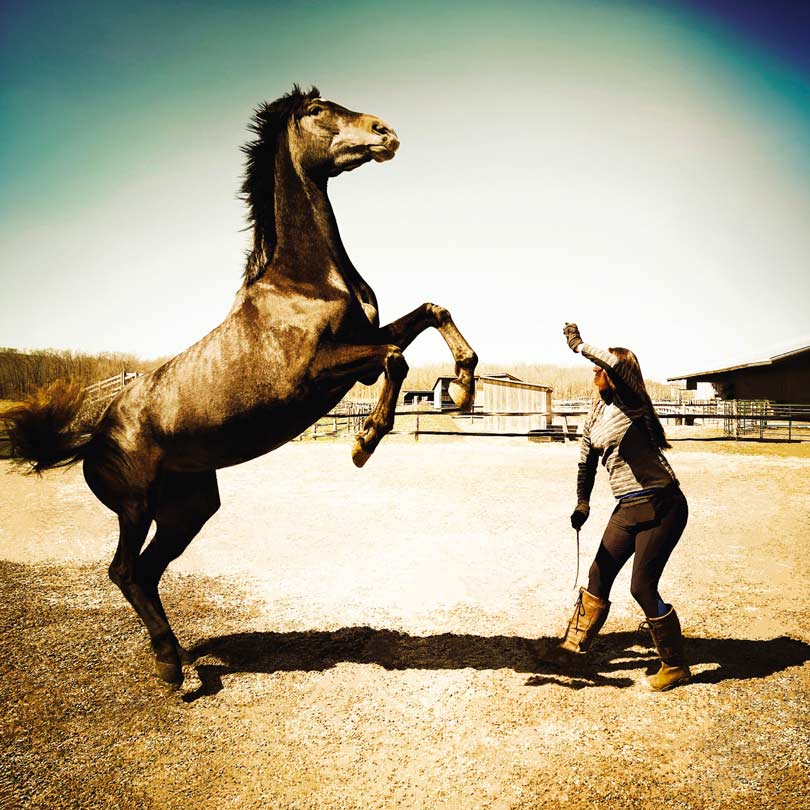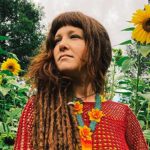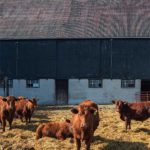

Passion and patience go hand in hand with cooperation and communication to forge trusted relationships at Partridge Horse Hill Farms.
Lindsey Partridge began riding at six, but by fifteen she was more interested in understanding horses and working with them than in riding. She believed there was a better way to train horses than relying on restraints, confinement and domination, and that belief led her to Liberty Training.
Lindsey’s concept is light years away from harsher methods used in the past. It gives horses unfettered freedom, which encourages them to develop a relationship with their human, building cooperation and trust in the training process.
“There are horse training books from the 1900s that describe how to tie a horse, make them fall over, and tie them to the ground, dominate them until essentially their spirit just dies. They no longer fight,” Lindsey says sadly. “They call it breaking a horse, as if that’s a good thing.” But Lindsey does it differently.
“We call it restarting,” she smiles.
A horse trainer for feature films, a competition coach, riding instructor and founder of the Harmony Horsemanship Academy, Lindsey is also a multiple Mustang and Thoroughbred Makeover champion. Two of her 2021 makeover winners, Elysia and Elon, currently live on Partridge Horse Hill farm near Pontypool. She trained the hot-blooded racehorse and little wild mustang to champion makeover levels in just three months – without “breaking” them.
HARMONY HORSEMANSHIP
Body language is crucial to communication with a horse. It is at the heart of Liberty Training, which uses positive reinforcement, creating a partnership and working with a horse’s natural instincts and abilities. Liberty is just one of the courses offered at Harmony Horsemanship, Lindsey’s business that reaches and teaches people all over the world, by harnessing the power of the internet.
“Before COVID, I was already offering online courses, sharing videos and advice, one-on-one sessions with feedback,” she says. Lockdowns boosted interest in Harmony online training and in her regular posts on YouTube and TikTok. She took on two dedicated staff to handle marketing and organize the business. They joined an existing team of five coaches – even more in summer – three chore hands and a farm manager.
There are currently 3,000 people signed up for Harmony courses, working at their own pace at different levels, and clients have lifetime access to the materials. “We have coaches working out of Partridge Farms, but working online is a much better use of my time,” she explains. “It gives me a huge reach and I can still work with students when I travel to events and trade shows.”
Lindsey is very eloquent, very calm. A colleague calls her “the most patient person I’ve ever known. Lindsey could outwait a tree.” And yet her life is crazy busy. She has four-year-old and ninemonth- old daughters, cares for ten horses of her own and boards others, runs an international training business, and – oh yes – breeds dogs. Four boisterous corgis scamper freely around the paddocks as Elysia and Elon go through their paces.
LIBERTY TRAINING
Before Liberty Training, Lindsey explored Natural Horsemanship, a collective term for techniques that promote gentler training methods. The philosophy helped inspire The Horse Whisperer book and film. “The core of it is using communication and leadership rather than intimidation and fear,” she says. “But it is falling out of favour because of heavy reliance on systemic pressure and release. Horses don’t like pressure and will do whatever they have to so they can escape it, and some trainers just keep adding pressure. That’s not the true spirit of Natural Horsemanship.” So she adopted Liberty Training, adapting it to suit herself and her horses.
Lindsey starts Liberty Training without tools or whips – not even a round pen. “In a round pen, a horse stays with you because they have to. That suggests their ultimate reward is to get away from you. That’s not what I want. I want my horses to see me as a happy place.” That dynamic was obvious when she appeared on TV with her horse in downtown Toronto, weaving in and out of the fountains in Dundas Square. “We could do that not because we trained intensively, but because the horses follow me and respond to my body language. They weren’t tempted to go running loose in the city because they had no reason to leave me. Instead they want to stick around and find out what I’m going to say, what we’re going to do next.”
Lindsey uses treats to reward her horses. “You probably noticed that,” she says wryly. In some circles food rewards are frowned upon. “That’s how my training has evolved,” she says. “Why would a horse want to be with me? I don’t want it to be because of threat or pressure. Food rewards to horses are the same as money rewards to people. If you haven’t yet figured out how else to motivate them, food is easy.
Once you become a team, when you’ve taught horses things and found out what they really like doing, you can move on without treats. In Grade 2, you get a gold star, right? By Grade 9, you don’t need that. To people who criticize, I say there’s research that says you can train a horse four times faster with treats. So all power to you if you want to take four times as long,” she laughs. “But I’ve got a fulltime job and two kids, so I’m going to use the food. The horse also knows it has the opportunity to earn so they’ll be thinking, hmmm, what can I do next?”
RESTARTS AND MAKEOVERS
After working bridleless with Lindsey, Elysia kicks up her heels and runs large looping circles, going faster and faster outside the paddock before she trots gently back to Lindsey, who has been waiting patiently.
“When horses come off the track, all they know is how to be professional athletes,” she explains, stroking Elysia. “Full of run and muscle power. Not everyone can handle that or knows what to do with all that energy. I can teach a horse how to go slow, how to relax and be safe with a child. For the most part, they just want to run and you can’t blame them, it’s what they’ve been taught; but to find a home off the track they need a new skill set. I like to learn what each horse wants to become.
“I love my horses and I’m proud of my ability to train them in a kind way, care for them and set them up for a successful future. There is a real thrill when you achieve something with a horse.” LINDSEY PARTRIDGE
“For our first ride, King, my 2022 thoroughbred, and I just walked in circles. We stopped and hung out together to say, ‘Look, you can relax, we can go slow.’ Eventually he will learn to jump and do obstacles. We’ve already done Liberty so we’re comfortable together and we can just play and figure out what he enjoys, what he’s good at. After the makeover events in October, I hope to sell him. By then we will know what kind of rider he needs, what kind of human he wants.”
She has found great matches for her makeovers. “Bling from 2019 loved to trail ride, and not all horses do, but she was so brave, and now she’s with a family that goes fox hunting and rides trails. Bowdrie from 2017 loves doing tricks and now she does demos for retirement homes. Their new owners could never have taken them straight from the track. It’s my way of helping horses.
“I love my horses and I’m proud of my ability to train them in a kind way, care for them and set them up for a successful future. There is a real thrill when you achieve something with a horse, when you progress because, honestly, they are so big! Even little Elon is six or seven hundred pounds, so you have to learn to co-operate with them, to understand their language.”
She is surprised how many owners, even trainers, don’t understand some very basic things. “Motion toward them will cause them to move away – they move away from pressure – but anything that’s going away from them, like you leaning back, invites a horse into your space. It’s just the way they operate. Yet many people misunderstand something as basic as that. For lunge training, you put the horse on the end of a rope, a lunge line, and have them run circles around you to exercise without someone on their back. They can move freely and learn things without the interference of a rider. But some people struggle because they try to shoo a horse forward while they are stepping backwards in the circle. They don’t understand that this is signalling the horse to come in, and they get frustrated. We teach that early on; it’s a core exercise we call spiral, how to bring your energy forward to send the horse out on the circle, and how to walk backwards to invite it to come back.”
At its most basic, Liberty Training makes people more aware of their own presence when they’re with a horse, more aware of what they’re doing with their energy. Are they being too assertive or too passive? Are they not making themselves clear? With tools or a rope you can cheat a little; with Liberty, your actions are stripped down.
A CONTINUUM OF CARE
Lindsey has 10 horses right now. “But that changes. I get horses for the Thoroughbred and Mustang Makeovers and I can’t keep them all,” she explains. “Part of the process is that some have to be sold. I’ve had people attack me who think it’s hardhearted, that once you get a horse and develop a bond, you should keep them forever. But my skill is getting these horses to be calm and relaxed and safe around people. If I kept them all, there would be a lot of horses I couldn’t help coming off the racetracks, a lot of Mustangs who would stay unmanageable, because I couldn’t take on any more. Selling the horse, moving on and getting another one is my best way of helping the horses.”
But there are some favourites she’s fallen in love with and kept. Soar, the thoroughbred that won the inaugural Makeover in 2015, is still at Partridge Horse Hill Farms. “She’s a lesson pony now,” Lindsey says fondly. “She’s happy to just plod around.” And maybe look on as a newly retired athlete learns to slow down, and a wild mustang learns to trust and enjoy a different kind of liberty.
Deborah Samuel
Composition through Connection
Photographer Deborah Samuel knows a lot about horses. She and her five siblings spent much of their childhood on their parents’ stud farm in Ireland. Deborah became one of Canada’s most sought after commercial and editorial photographers in the 1980s, moved to Los Angeles in the 1990s and shot fashion and celebrities for the likes of Rolling Stone, GQ and Esquire before walking away from that world. “It was like another planet,” she says, “and I had to get back to earth.” She escaped to New Mexico and turned her focus to fine art photography – and horses.
In New Mexico she worked on a mustang ranch alongside the cowboys, but after 17 years, it was time to leave. “It was getting very weird down there,” is how she puts it. She drove home to Canada in her big old truck, bringing her own little mustang with her, and settled in Prince Edward County near her glass artist sister Kirei and brother Rob, a woodworker.
Deborah published three books of personal work, Dog, Pup and The Extraordinary Beauty of Birds, the latter in collaboration with the Royal Ontario Museum, and now she has a fourth book. Elementals is a collection of landscapes that she has loved, in Ireland, America, Africa and Canada. Ten years in the making, the gorgeous images were all shot on an iPhone. “It doesn’t matter what equipment you use, as long as you have something to say,” she says. Galleries find it hard to categorize her; she has been called “skilled in the bizarre and beautiful,” but Deborah insists, “I do portraits. Whether it’s dogs or bird bones or horses or weather, I am basically making portraits.” Beautiful portraits.
You can see more of her work at deborahsamuel.com
Story by:
Janet Davies
Photography by:
Deborah Samuel


